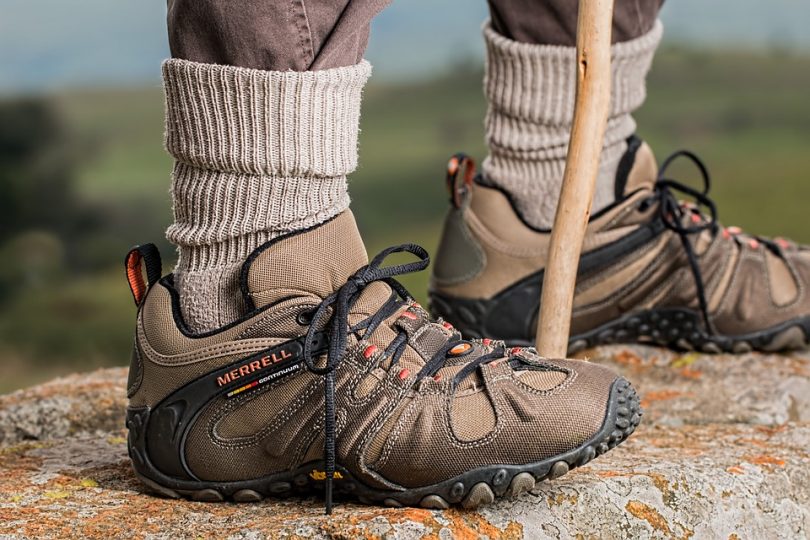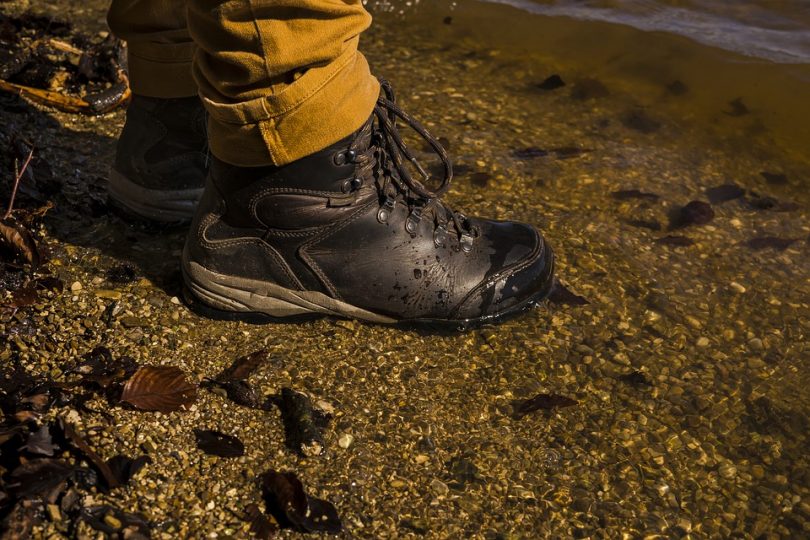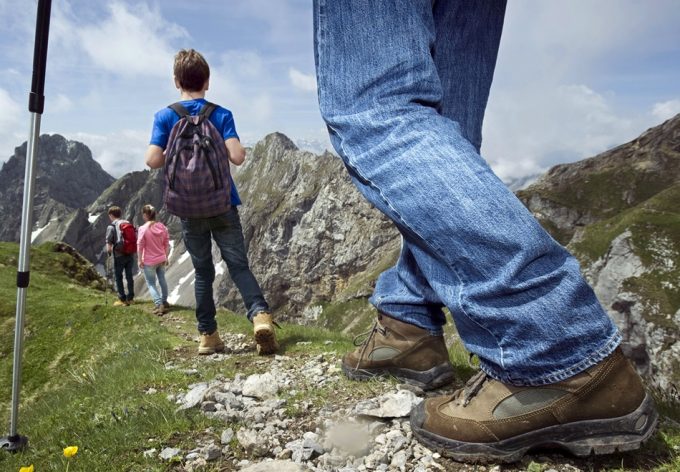Hiking Shoes vs. Hiking Boots: How to Choose the Best Hiking Footwear
One of the most critical hiking assets is your feet. You have to protect them from water, mud, rocky terrain, thorns, snake bites, and so on. The best footwear has to protect you from the trail and its dangers. This is so since some trails are rough while others are smoother.
[the_ad_group id=”21″]
When preparing for hiking, you have to assume that all the tracks will be hard to walk on. There are times when the track can be too hot or too cold for you to handle. You need hiking shoes or boots to avoid any damage to your feet. This guide provides you with info on hiking shoes vs. hiking boots.
Step 1 – Know the Various Types of Hiking Footwear
Hiking Shoes
Hiking shoes are specifically designed to fit the feet below the ankle with flexible leather or plastic upper, and a sole and heel of heavier material. The best shoes have lug patterns that offer stability in all terrain and weather conditions. Lug patterns ensure that your feet stretch naturally for better control and comfort. See a comparative review of hiking shoes vs. boots for more information .

Traction is very important on both dry and wet surfaces regardless of the temperatures. The interior of the best hiking shoes should be made of hiking quality material to ensure that sweat, as well as moisture, does not affect the cleanliness of your shoes. The best pair is incorporated with antimicrobial agents that prevent the formation of odor.
Trail Running Shoes
The definition of what counts as trail shoes is slightly blurred, but they are basically shoes that have far less cushioning on the sole. Normally, less softening helps you to feel the trail, ensuring that you have a more natural run.
The most beneficial of these shoes is the fact that they aid your feet to run, but at the same time helping your feet to run the way they were structured. Most trail running shoes have a considerably more forgiving sole.

Usually, they feature distinct lugs that are very helpful with traction. Trail running shoes are commonly manufactured in low cut designs not to mention that they are made with soft neoprene soles for suppleness while running. However, these shoes provide you with aminimal shield around the toes.
Hiking Boots
Hiking boots are footwear that covers the entire foot and lower leg. They protect the feet as well as the ankles from any dangers of the trail. Unlike hiking shoes, boots are considered to be stronger and durable.
See also: Best Vegan Hiking Boots: Maximize Trail Time, Minimize Impact
They are engineered to provide you the comfort you need for trekking over rough terrain for hours. Hiking shoes do not protect your ankles and lower legs, but boots do and they are objectively stiff.

The best trekking boots are made of leather and fabric, have rubber sole, they are gusseted tongue, they have protective heel caps and rubber toe, and they are incorporated with waterproof membrane. Generally, hiking boots are particularly comfortable, especially for alpine climbing.
Step 2 – Choosing Upper
This is probably the hardest step when choosing between hiking shoes and boots. With various kinds of footwear to choose from, it pays to know the marks of quality construction for both hiking shoes and boots.
Full Grain Leather
Features: There is natural distinctions in grain texture & shading; growth lines or fat wrinkles; small scars; and superior base dye penetration.
The very best footwear is made of full grain leather. This material does not have surface alterations. The material develops a covering with time, but the hide’s grain textures and pores are usually intact. The high quality surface is due to the presence of the hair follicles.

This material is highly breathable; therefore, the footgear’s temperature is regulated effectively. As far as leather shoe/boot materials are concerned, full grain is known to be of the highest quality. It offers exceptional water resistance, abrasion resistance, and durability.
The material does not soak water when you happen to walk on humid environments, and it does not scratch easily when you are busy climbing uphill.
Split Grain Leather
Features: Less expensive; flexible & soft; comes from softer part of the hide; & highly breathable.
Split grain leather is the second or third layer of a given hide. Although not as hard-wearing as full grain, it is flexible and soft.
It is fine for upper structure, but it is thinner when compared to full grain, and it is obtained from a softer part of the hide. In most footwear constructions, split grain is normally combined with nylon to develop ultra-lightweight hiking boots that provide you with remarkable breathability.

By design, this leather splits away what is considered rougher inner section of the cowskin from the slicker exterior part. The major downside of this material is minimal waterproof capabilities.
However, most foot gears made of this material are installed with waterproof liners. Split grain leather footwear does not handle abrasion very well, and they are not as durable as full grain.
Nubuck Leather
Features: Buffed full grain leather; abrasion resistant; durable; requires break in; similar to suede.
This is top grain leather which has either been buffed or sanded on the grain part to provide a slight nap. In other words, it is buffed full grain that bears a resemblance to suede.
This material is highly susceptible to staining and soiling, and you must clean as well as protect it by using the appropriate products and tools.

Shoes made of this material are not highly recommended for hiking. You can still buy them, but expect them to show some considerable weakness, especially when you expose them to extreme environmental conditions.
Other Materials
Hiking footwear upper constructions include synthetic materials, such as synthetic leather, nylon, and polyester. Many hiking shoes are made of synthetic materials.
Therefore, they wear faster, cost less than real leather, break in faster, and they are remarkably light. You should only go for hiking footgear made of these materials if you want to cut on cost, but you should expect low performance.
Step 3 – Choosing Midsoles
Most of the recent advances in the outdoor footwear industry have been made in midsole materials and design. The heel wedge, as well as the midsole, is packed in between the outsole and upper, which offer control, lift, shock absorption, and cushioning. The midsole are actually the foundation of the entire footwear.

It is in this part that many of the technological innovations that have taken place that have made hiking boots ultra-lightweight, more responsive, and softer to the foot.
When the design of most outdoor boots/shoes changed a while ago; growing lighter and more flexible, most of the weight existed on the sole. Basically, the midsole became lighter while the outsole became thinner. The following are the most preferred midsole materials.
EVA Midsoles
Also referred to as ethyl vinyl acetate, has long been a recognizable midsole material. It is exceptionally light, and it offers acceptable stability and shock absorption. The major downside of this material is the presence of open air cells. These air cells make the midsole wear out rather easily and quickly.
Usually the relentless compression and decompression of the midsole that occurs during hiking ultimately cause them to lose much of the shock absorption capabilities. The best midsoles are made of dual density along with a softer EVA on the exterior.
Polyurethane Midsoles
As we mentioned earlier, midsole is the main motion controller and shock absorber. Therefore, it has to be made of the best material. Most designs are made of EVA, but this material is known to lose the shock absorbing abilities after a few hundred miles of hiking. With that said, the most preferred alternative is polyurethane material.

PE material is highly durable, less compressible, and lightweight. In the simple words, polyurethane is sealed foam that is capable of holding longer when compared to EVA. Nevertheless, there is a significant downside of polyurethane.
The material is heavy, thus gives a larger load to carry, and a pair of heavy hiking shoes or boots inflict more strain on the foot and leg muscles. This significantly increases injury severity.
Encapsulated Midsoles
This is a more sophisticated midsole material, which is yet to combine good rebound energy and cushioning. This material is made up of polyurethane foam encompassing encapsulated layers of other cushioning materials.
This material is more resilient, but polyurethane is usually expensive; therefore, shoes or boots installed with these midsoles are also expensive.

Step 4 – Choosing Outsole
The outsole of your hiking shoes or boots is the most undersurface that comes in contact with the trail, and it is attached to the midsole to develop the entire sole.
In actual fact, this is the part that takes most of the abuse when you are hiking or climbing rocky terrain. The outsole material varies with respect to boot/ shoe type. Most outdoor footwear has outsoles made of blown rubber compounds or hard carbon rubber.
[the_ad_group id=”22″]
These two materials are highly durable and long lasting; they will rarely show substantial wear for a considerable amount of time excepting extreme conditions. Most outsoles are designed from an arrangement of compounds, such as fillers, natural/synthetic rubber, and vinyl plastics.
Normally, rubber materials provide reliable slip resistance when compared to PVC compounds. Vinyl plastic outsoles do wear longer as to rubber outsoles, but rubber outsoles tend to conform effectively to the ground’s natural texture, offering better slip resistance.

Contemporary outsoles constructions may consist of five or more compounds. Most individuals may claim that leather is slippery.
Well, that is certainly true, but leather grows less slippery when broken in, and it’s less slippery on wet surfaces because of its water absorptive properties.
Generally, the material of the midsole along with the outsole determines the quality of a hiking shoe or boot. Only good outsole material will prevail on rough and unforgiving terrain, especially when you are involved with alpine climbing.
Step 5 – Important Features to Consider
A Supportive Upper
The upper of hiking shoes and boots has to be supportive. Typically, a trekking shoe or boot must have a more supportive upper than ordinary running footwear.

A heavy duty upper is built with sturdier construction, and firmer materials, such as waterproof synthetic composites or full grain leather instead of aninferior mesh of an ordinary shoe. A well-designed upper is supposed to hold your foot in a better position at all times during hiking.
Durable Construction
The best trekking footwear should be made of resilient construction, such as welt or cement construction. Welt boots are designed by edging together the midsole, upper, and welt. The welt is simply an additional leather strip. Statistically, welt construction is unbeatable for long wear.
However, you must confirm that the welt is made of leather or synthetic materials. Basically, leather is a more preferred choice since it does not crack easily.
With that said, most top quality trekking boots are integrated with cemented construction. Quality construction guarantees more than long wear. You get additional comfort regardless of how long you will be on the trail.

A Low Profile & a Toe Bumper
Reliable hiking footwear should be flatter and lower to the ground, and it should not be exceedingly raised. A low profile offers a more stable base to come down on whenever your feet hit the ground. High profile footgear has a tendency of rolling over whenever you make a wrong move.
In very simple words, the probability of you twisting your ankles is significantly low when wearing low profile shoes/boots as compared to high profile shoes/boots.
An effective toe bumper is necessary, since chances of your big toe colliding with a bigger rock are high, especially when alpine climbing. The best bumper is made of rubber and wrapped around as well as up the front of the shoe/boot for protection.

Traction
Effective traction is important when hiking, especially if you are involved in alpine climbing or when going downhill. Deep lugs on the outer sole offer better adhesive friction and a longer trekking life.
The grooves on your outsole have to be deeper for a resourceful level of traction as well as longevity. Boots or shoes that can prevent clogging must have thicker lugs, which keep you trekking on extreme environments, such as mud, rocks, or snow.
You should know that shallow treads wear down easily, particularly when worn on rocky terrain, but deep treads will effectively cut through almost any environment.

Water Resistance
It does not matter whether they are hiking boots or shoes, waterproof capabilities are extremely important. Footwear that can effectively repel water helps to keep your feet dry and odor free.
The materials of the upper, as well as the interior, must be waterproof and highly breathable. You should know that a large number of low or average quality hiking shoes and boots are not properly treated for water resistance. Usually, you can make your own boots or shoes water repellant, but it is always good to spend on quality.
Step 6 – Best Fit
The worst mistake you can make when shopping for hiking shoes or boots is buying footwear that does not fit. You can either buy shoes/boots that are too tight or loose. Either way, you would have lost your investment. Therefore, you need to know your size. Foot sizing includes the arch length and foot width and length.
Use a properly calculated device to make the above measurements. Your foot volume is also important in determining a good fit. A store specialist can help you with the volume.

Making online purchases can be a bit tricky, because you will not be able to try the footwear on the spot. This is so since you must try the shoes or boots to gauge the fit and comfort.
You also have to wear the desired socks when testing the fit for the first time. You cannot test the fit with lightweight synthetic socks, and expect the shoes or boots to fit when you wear them with thick merino wool socks. You should only do online shopping if you know your exact fit.
Therefore, you must have made a previous purchase and you are certain about the measurements and foot volume. The best fit is also promoted by resourceful insoles or footbeds. So, consider purchasing some if they are not freely given. You can commendably hike or climb if your feet are comfortably inserted and tacked inside the best fitting shoes or boots.
In Conclusion
The utmost truth is that a hiker’s shoes or boots cannot avoid the harsh conditions of the trail. This is so since they are subjected to disintegrating cushioning, ripped material/ stitching, and flatten soles among others. If your boots or shoes give in, your feet are the ones that will suffer the consequences.

[the_ad_group id=”23″]
Therefore, it is extremely important for you to make as many considerations as possible. The above mentioned steps can help you make the most profound purchasing decision. You should not just be satisfied with the exterior of the boots or shoes irrespective of how attractive and promising they look. Do read our review of the best insoles for hiking, definitely something to check on.
Do additional inspection and determine whether or not a given pair of hiking shoes or boots is good enough to overcome the horrors of the trail.







I wish I could find a middle ground between the lightness of trail runners and the ankle support of boots. I have looked at a few hi top trail runners, but have found them to be lacking in either ventilation, durability, or support. I had to settle on a pair of Keen Voyageurs. They are pretty ok. Very durable, pretty breathable. I don’t care much about waterproofing, so I didn’t bother with that. I was more interested in breathability. Have you found any good hi top trail runners?
I can definitely understand where you’re coming from. It is quite daunting sometimes to find the best hi top trail runners. I do go for Merrell, both for the quality and price point. Other choices perhaps could be Salomon. Then again, it is best to check them out and fit which ones is okay with you.
I wish I could find a middle ground between the lightness of trail runners and the ankle support of boots. I have looked at a few hi top trail runners, but have found them to be lacking in either ventilation, durability, or support. I had to settle on a pair of Keen Voyageurs. They are pretty ok. Very durable, pretty breathable. I don’t care much about waterproofing, so I didn’t bother with that. I was more interested in breathability. Have you found any good hi top trail runners?
I can definitely understand where you’re coming from. It is quite daunting sometimes to find the best hi top trail runners. I do go for Merrell, both for the quality and price point. Other choices perhaps could be Salomon. Then again, it is best to check them out and fit which ones is okay with you.